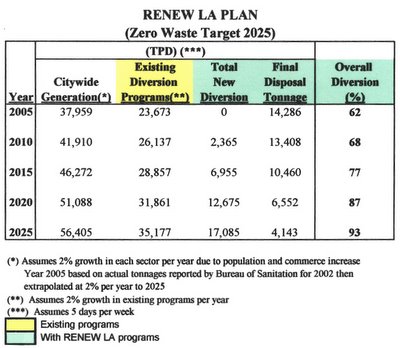This is a Los Angeles area local newspaper article that describes a bold, urban, conversion technology plan and the current struggle to get California state regulations passed to allow it to be implemented. The proponents are a determined coalition of waste policy professionals, environmentalists, politicians, scientists, utilities, and municipal organizations versus an entrenched but myopic group of recycling and landfill special interests. The stakes are high because AB 1090 could be the tipping point for a paradigm shift for Californians away from fossil fuel dependence, toward a clean cellulosic ethanol and green energy future based on pyrolysis and syngas fermentation waste conversion technologies.
----------------------------
R.E.N.E.W. L.A.: A Sound Plan for Renewable Energy
by C. Scott Miller
 Los Angeles Councilmember Greig Smith is a man of vision, who talks with great conviction about “paradigm shifts”, “zero waste”, and “conversion technologies.” He is in a good position to initiate concrete action as a mover and shaker in Los Angeles politics (one of 15 L.A. City Councilmembers). And he is motivated—representing, as he does, an educated, demanding constituency in a L.A. bedroom community (District 12 - the northern rim of the San Fernando Valley) that is determined to see an end to its BFI-operated "Sunshine Canyon Landfill" and the attendant problems that go with it (noise, traffic, smog, odors, seepage, depressed real estate values). With the passage of simple regulatory changes in Sacramento, Smith can begin to implement the first phases of his comprehensive plan for Los Angeles trash.
Los Angeles Councilmember Greig Smith is a man of vision, who talks with great conviction about “paradigm shifts”, “zero waste”, and “conversion technologies.” He is in a good position to initiate concrete action as a mover and shaker in Los Angeles politics (one of 15 L.A. City Councilmembers). And he is motivated—representing, as he does, an educated, demanding constituency in a L.A. bedroom community (District 12 - the northern rim of the San Fernando Valley) that is determined to see an end to its BFI-operated "Sunshine Canyon Landfill" and the attendant problems that go with it (noise, traffic, smog, odors, seepage, depressed real estate values). With the passage of simple regulatory changes in Sacramento, Smith can begin to implement the first phases of his comprehensive plan for Los Angeles trash.
The R.E.N.E.W. L.A. Plan
Smith and his staff have spent two years developing R.E.N.E.W. L.A. – a 20-year plan to revamp waste disposal in Los Angeles County. This would be accomplished by greatly extending the recycling of black trash bin waste (garbage for which no current recycling use exist). New emission-free conversion facilities, modeled after similar modern processing centers in Europe, would be built in multiple sites throughout the county creating new streams of employment income in each location.
With this plan it would be possible to divert the amount of waste currently going to landfills by up to 80% by the year 2025 (including allowances for growth). Using new emission-free technology witnessed by the entire L.A. City Council, converted trash could be processed into ethanol with heat from the gasification stage used to generate “green” electricity. About 75% of the waste not already being recycled could be used as feedstock for this advanced process.
Statewide these technologies could produce more than two billion gallons of low-cost ethanol and 2,700 MW of green power from the 40 million tons of post-recycled waste that are being put into landfills each year. Currently, in every tank full of gasoline purchased in California, there is about 1 gallon of ethanol which is blended in as an oxygenate – 99% of which is imported from the Midwest and nations like Brazil. This clean, renewable fuel can help us significantly reduce America’s dependence on fossil fuels, principally petroleum, while having a huge positive impact on our economy, environment, and quality of life.
California AB 1090 – The Conversion Technology Bill
So what is holding up implementation of this well-conceived plan? Current state law requires these new technologies to be permitted as if they were major waste treatment facilities (i.e., landfills) a process that could take years. A contentious battle is being waged over the passage of a seemingly mundane piece of legislation called “CA AB 1090”. This bill would define “conversion technologies” (CTs) in state law, bringing regulations up-to-date that were established as many as 15 years ago, before some of these technologies had even begun development. It would equate conversion with recycling because both processes turn trash into usable products.
The fight over AB 1090, sponsored by the BioEnergy Producers Association (led by former State Sen. David Roberti) has been surprisingly fierce. In support of the bill is a broad, bi-partisan cross-section of California communities, sanitation districts, labor, agriculture, waste haulers and others. Supporters of the bill include municipalities that will face fines if they are unable to comply with the state’s mandate to divert 50% of their waste from landfills. Labor groups forecast the creation of thousands of quality jobs throughout California. Utilities need these technologies in order to meet their state mandate for the production of renewable electricity, or “green power.” Agricultural associations are seeking alternatives to the open-field burning of their wastes and the spreading of sewage sludge on their lands. Progressive waste management companies realize that the era of landfills is over and that these new technologies can turn today’s wastes into tomorrow’s liquid and electric energy, increasing their profitability—even making it possible to “mine” and recover materials from existing landfills.
Studio City's resident environmentalist, Ed Begley, Jr., wrote a letter firmly in support of AB 1090: “The antiquated paradigm of treating solid waste as ‘trash’ – i.e., burying it in the ground creating pollution in the air, land and water – needs to change. That ‘trash’ is a resource, a valuable commodity completing the cycle of birth-to-birth/cradle-to-cradle.”
And who is leading the opposition to these innovative waste management solutions? A group named “Californians Against Waste” (CAW), the lobbying and advocacy association supported by many organizations in the traditional recycling industry and the operators of landfills.
CAW’s true objective is to prevent competition for California’s waste streams and force municipalities to use traditional recycling methods to meet their state mandate for 50% waste diversion from landfills. This was confirmed by Scott Smithline of CAW, who was quoted as saying, “We are concerned that demand, that hunger for feedstock, is going to pull materials from other traditional recycling uses.”
Proponents of the bill counter that those assurances are guaranteed in the plan. And, as Ed Begley, Jr. points out “When recyclers export materials to China, municipalities receive credit for diverting wastes from landfills. When green waste is used as alternate daily cover, these same agencies get credit; but if you use the same green waste to produce low-cost green electricity and liquid energy for California’s citizens, municipalities do not get a diversion credit. These inequities need correcting.”
Correcting these inequities is the responsibility of the California legislature. AB 1090 failed to get a scheduled hearing in the Assembly Natural Resources Committee in Sacramento January 9th. When it is re-filed, the chances are that, due to the political influence of CAW, there will be no diversion credit provision in it – no incentive for California municipalities to provide their wastes to the producers of electric energy, renewable liquid fuel, and other bio-based products.
--------------
C. Scott Miller is a Studio City resident and editor of the BioConversion Blog.












